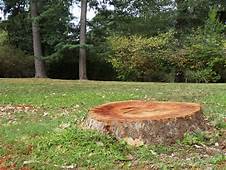Written by Rachel Klein and published on https://assets.doityourself.com/
Removing stumps is a complex and time-consuming job and it requires good knowledge of the different methods available and which would best suit this stump situation. When you hire a service for land clearing, stump removal can be a part of that. Professionals in the industry can do it faster and have all the equipment needed. Some property owners choose to ignore tree stumps but ideally, you should remove them. It is better for you in terms of causing injuries, and they can attract pests and become less attractive looking as vegetation grows on them.
Table of Contents
Safe Tree Stump Removal – 5 Methods

There are 5 basic methods for tree stump removal. Once a tree is cut down, the remainder of the trunk and the roots will eventually die and begin to decay, but that can take time you don’t want to waste. You may have several good reasons for wanting to eliminate the stump as soon as possible, but removing a tree stump is no easy task.
TIP: A popular method of stump removal involves hooking the stump up to a pickup truck and driving like crazy. Bad idea! This method has been known to seriously damage cars while leaving stumps basically intact.
1. Chemical Tree Stump Removal
There are several chemical products available at home garden centers that assist in and hasten the rotting of a dead tree stump. Most products make use of potassium nitrate to expedite the decomposition process. Chemical fertilizers high in nitrogen produce bacterial growth that will facilitate the gradual decay, which makes the stump become easier to remove. In each case, holes are drilled into the stump with a large diameter drill bit, filled with the chemical mixed with water, and left to work over time (usually weeks or months). After the chemical has taken effect and the stump has become soft and mulchy, use an axe and/or a pickaxe to break up and remove the stump.
WARNING: If using a chemical stump remover, it’s very important to keep children and pets away from the stump while the chemicals do their work.
2. Mechanical Removal With a Tree Stump Grinder
Wearing proper safety gear is very important when attempting to remove a tree stump manually or with heavy machinery. Wear long sleeves, long pants, eye protection, and steel toe boots! A mechanical tool known as a tree stump grinder can be used to remove tree stumps. It consists of a toothed circular cutting blade that grinds or chops away the stump, breaking it into small chips. Before using a tree stump grinder, remove any rocks and debris from around the stump. Then use a chain saw to remove the bulk of the stump by cutting it as close to the ground as possible. The grinder is worked from side to side, removing 3-inch sections of the stump with each pass. This method is best when you have multiple tree stumps to be rid of. You can rent the machine at a garden supply store, or pay a landscaper to take the stumps out on a price-per-stump basis. If your stump is very large, you may be forced to hire a landscaper. Rented tree stump grinders are not usually big enough to tackle huge projects.
3. Manual Removal
If the tree stump is not too big and you intend to dig it out manually, do not attempt to remove the entire stump and all of its roots intact. This is time-consuming and unnecessary. Begin by digging a trench around the perimeter of the stump and expose as many roots as possible. If you can do so without damaging the cutting blade, cut through the major roots with an axe or a circular saw. Use a pickaxe to loosen the soil around the stump, working your way around the stump and prying it loose from all sides until it comes free. Do not dig the trench too close to the stump! The wider your circle, the more room you have for maneuverability. This method is best used on trees with shallow root systems, such as maples and willows.
4. Removal With Fire
One common way to eliminate large tree stumps is to literally burn them out. Drill holes into the stump with a large diameter drill bit, fill the holes with kerosene or fuel oil (never gasoline), and wait for it to soak in thoroughly, about a week to 2 weeks. Drop one match into each hole and wait. The stump will smolder for days, and eventually you will be left with a charred hole. It is important to keep children and pets away from the smoldering stump. This method is best used for small stumps or in conjunction with another method. For example, if you have stump left behind after a chemical or manual removal.
WARNING: Be sure to check your local fire codes before using this method or you may get fined. Never leave the burning stump unattended.
5. Natural Removal
There is another alternative method for tree stump removal—doing nothing at all. Once a tree is cut down the stump will begin to decompose. It can simply be left in the ground to rot. This is a viable option if the stump is not too large in diameter. Covering the stump with fertilizer, soil or mulch will help to generate the fungus and bacteria that causes decay. In time the stump will reach the point where it can easily be extracted from the ground with minimal effort.
TIP: If you don’t like the look of your stump while you wait for it to decay, put a planter right over the top and plant something else inside. You might even forget it is there!
Original post here https://assets.doityourself.com/stry/safe-tree-stump-removal–4-methods/.

